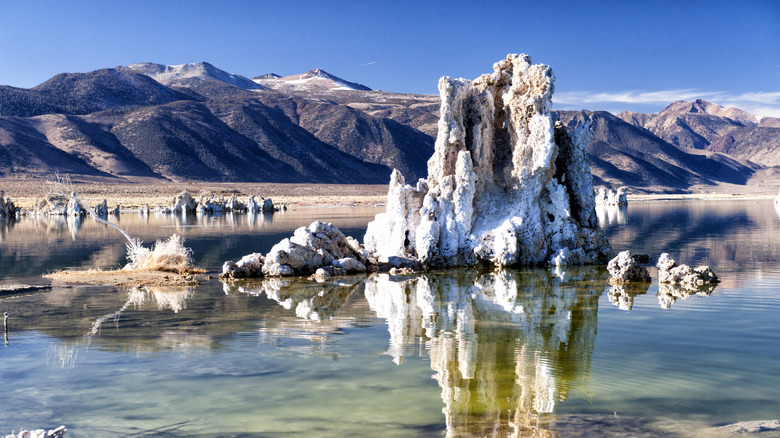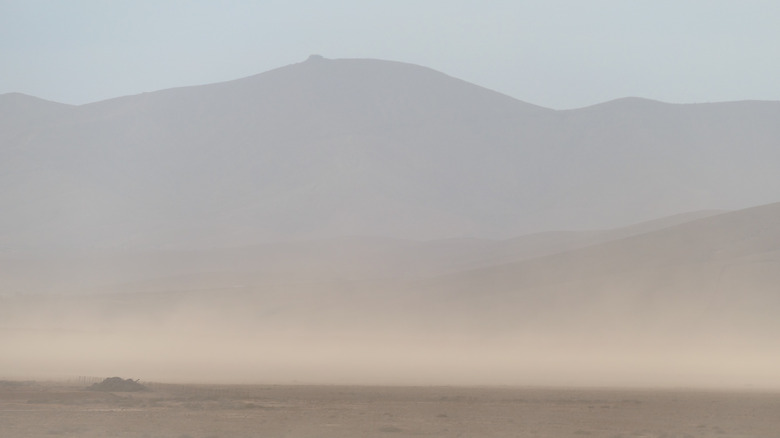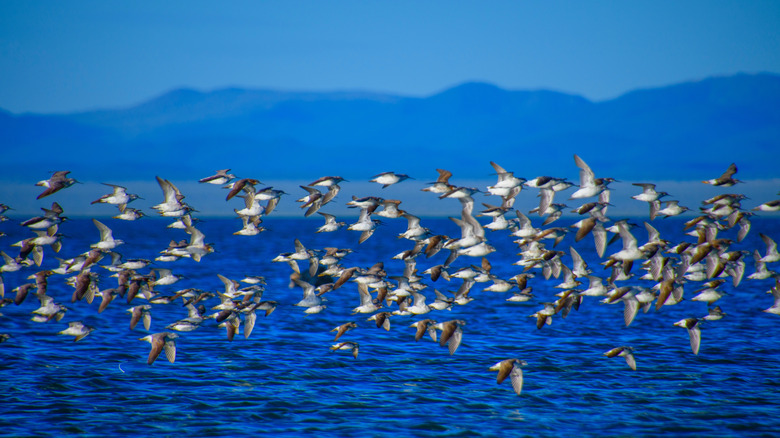This Unique California Lake With Otherworldly Rock Formations Is More Dangerous Than It Looks
For many, California's Sierra Nevada range is heaven incarnate— a gorgeous wall of rock and lofty, jagged peaks thrusting straight up from the earth. While most famous for majestic sites such as the scenic Yosemite National Park, Sequoia, and Kings Canyon – a national park where you can experience some of the largest trees in the world – the region is also home to stranger, more under-the-radar attractions, including the surreal, but very beautiful, Mono Lake.
Situated on the Sierra Nevada's eastern flank just an hour up the road from this dazzling gateway California city, Mono Lake is a 65-square-mile body of water that was formed over 1 million years ago. Fed by streams and snowmelt, the lake has no outlet, and over time, the minerals left behind by evaporated water have reacted to form tufa — massive underwater towers made of calcium carbonate (limestone). The lake level has fallen dramatically over the years due to excessive water diversion, leaving countless tufa towers exposed, which lend the lake the otherworldly feel it's become famous for.
However, all of the minerals left behind has made the water in Mono Lake incredibly salty and toxic, with a pH of 9.8, which is on par with household glass cleaner. The water also contains arsenic, and while drinking from this lake certainly could prove fatal for humans, the real danger lies above the waterline. At certain times, the air at Mono Lake is incredibly hazardous, often with the highest levels of particulate air pollution in the U.S.
Know the dangers of visiting this beautiful, shrinking lake
Despite its toxicity, water from Mono Lake is used by the City of Los Angeles, which has caused the lake to fall to critically low levels. While this has made thousands of tufa towers visible —which in turn attract nesting birds such as gulls, terns, and osprey — it's also exposed the highly alkaline lakebed. Sitting on the flank of one of America's great mountain ranges also means that Mono Lake sees a lot of wind, which kicks up dust from the lakebed, creating a hazardous miasma for any humans in the vicinity.
While wind can hit Mono Lake at any time of the year, it's particularly fierce and persistent throughout the month of October. Breathing in the superfine PM10 particulate found in the exposed lakebed (and then whipped up by the Sierra winds) can be particularly harmful for people dealing with bronchitis, heart disease, asthma, and other respiratory conditions. Also, the bad dust isn't just confined to the lake. It can be blown far and wide, affecting local communities and reducing visibility to less than a quarter mile.
Despite the hazards, Mono Lake is a unique destination to visit
Despite the potential dangers for breathing in fine dust particles, Mono Lake is a terrific destination for anyone keen to take in nature in its most unique form. The chemicals that can cause harm also lend the lake its haunting appearance, forming the tufa towers which rise above the surface like alien castles. Mono Lake is a place of singular beauty — a serene, glassy expanse punctuated by marvelous forms in front of the stunning backdrop of the Sierra Nevada.
What also draws visitors to Mono Lake are its populations of migratory birds. Because of the high levels of salinity, there are no fish in the lake; instead, the waters are full of brine shrimp, which are a food source for birds. Over 80 avian species can be found at Mono Lake throughout different times in the year. Some 50,000 California gulls arrive in the summer — as well as flocks of phalaropes — while 1 to 2 million eared grebes stop off in the fall.
If you're feeling adventurous, it's also possible to swim in Mono Lake. The lake's high salinity results in significant buoyancy, which means it's very easy to float on its salty surface. Just be aware that the salt can also sting your eyes and cuts, scratches, or wounds, so take precautions before jumping in and swimming with the shrimp. For a more user-friendly California freshwater experience, check out this dazzling lake where the Cascades and Sierra Nevada meet.


